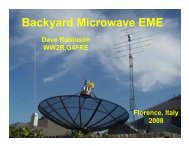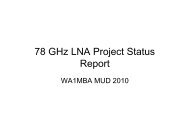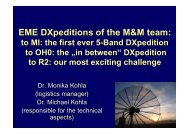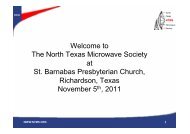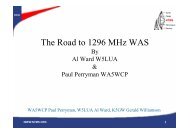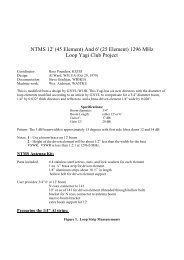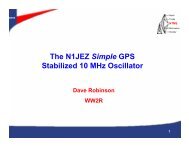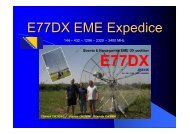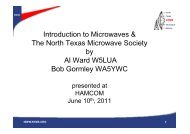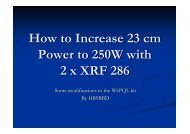AD6IW - High Efficiency Solid State amplifiers - NTMS
AD6IW - High Efficiency Solid State amplifiers - NTMS
AD6IW - High Efficiency Solid State amplifiers - NTMS
- No tags were found...
You also want an ePaper? Increase the reach of your titles
YUMPU automatically turns print PDFs into web optimized ePapers that Google loves.
<strong>High</strong> <strong>Efficiency</strong> solid<br />
state <strong>amplifiers</strong><br />
EME Conference 2010, Dallas Texas<br />
Goran Popovic <strong>AD6IW</strong>
• Performance reliability and life expectancy of RF semiconductor devices are<br />
inversely related to the device temperature. Reduction in the device temperature<br />
corresponds to an exponential increase in the reliability and life expectancy of the<br />
device<br />
• Lower power consumption, longer battery life<br />
• Lower heath dissipation, smaller amplifier size, weight and heat sink size<br />
• Lower Power supply and heat sink requirements<br />
• Better Amplifier Linearity<br />
• Lower Cost<br />
• Possibilities to mount amplifier and PSU close to antenna and eliminate cable loss<br />
• Maximum efficiency of a RF power device is a function of frequency, temperature,<br />
input drive level, load impedance, bias point, device geometry, and intrinsic<br />
device characteristics.<br />
• How well a device converts one energy source to another.<br />
• Heath as byproduct<br />
• <strong>Efficiency</strong> depends on amplifier class, gain, output power and power dissipation.<br />
• <strong>High</strong>est efficiency at peak output power PEP, P1db<br />
Overview:
Drain efficiency<br />
Power added efficiency, PAE<br />
Drain <strong>Efficiency</strong> and PAE
Drain <strong>Efficiency</strong> and PAE as a function of Vds for a class<br />
B LDMOS power amplifier<br />
Average efficiency<br />
ηAVG = PoutAVG/PinAVG<br />
Drain <strong>Efficiency</strong> and PAE vs. Vds
• Si BJT, high collector breakdown voltage, typically operate at 28V, up to 5 GHz<br />
and up to 1kW pulse applications. Positive temp coefficient, temperature runaway<br />
• Vertical RF power MOSFET, 1KW at HF, hundreds of Watts at VHF.<br />
Typically operate at 12V, 28V or 50V, and some at >100V<br />
• LDMOS UHF and lower uW frequencies, typically operate at 28V, 50V<br />
hundred watts @ 2GHz, low cost. L band Si LD MOS > 50 % efficiency<br />
• GaAs MESFET, higher mobility – higher frequencies, 200W @ 2GHz, 40W @ 20GHz,<br />
Low breakdown voltage, typically operate from 5V to 10V.<br />
Depletion mode, require negative bias voltage, poor linearity<br />
• X band MESFET amps with 10 % BW up to 30 %<br />
• GaAs HEMT high ft up to 150 GHz, 15W at 12GHz PAE 50%<br />
100W at S band<br />
RF Transistors Technologies
• PHEMT <strong>High</strong> efficiency up to 45GHz, and useful to 80GHz,<br />
40W at L band<br />
• X Band PHEMT amps can exceed 40% PAE,<br />
Ka Band 20 % to max. 30 %<br />
• SiC MESFET high mobility and break-down voltage, double than Si<br />
LDMOS, Power densities ten times that of a GaAs MESFET, high thermal<br />
conductivity. Typically operate at 48V, and power levels 10 to 60W up to<br />
2GHz.<br />
• The cost of Sic is ten times that of Si LDMOS<br />
RF Transistors Technologies
• GaN HEMT same as SiC even higher mobility and higher operational<br />
frequencies, <strong>High</strong> breakdown voltage, low thermal resistance,<br />
8W at 10GHz with 30% efficiency. Soft compression, not for class A, but<br />
ideal for AB, E, F class. <strong>High</strong> cost.<br />
• HBT, SiGe experimental power amplifier HBT 200W at L band<br />
• Wideband amps, low efficiency 2-18GHz 10 %<br />
• TWT 60 %<br />
RF Transistors Technologies
Class A amplifier, high quiescent current, 360 deg<br />
Conducting angle, highest gain, frequency and<br />
Linearity. Low efficiency, theoretical 50 %<br />
Class B amplifier, the quiescent drain current is<br />
Zero, but in praxis 10% of drain current. Ideal for push<br />
pull amps. <strong>Efficiency</strong> theoretical 78.5 %<br />
Class C gate is biased below threshold, transistor is<br />
active less than half cycle 150 deg. Linearity is lost<br />
for higher efficiency 85 %<br />
Class D generate square wave drain voltage waveform.<br />
Theoretical Eff 100%, suffer from Drain<br />
capacitance, saturation. Up to 1KW at LF/ HF<br />
Class E operate as switch, no V/I overlapping<br />
KW HF amplifier with switching transistors.<br />
Drain capacitance and saturation. Eff 100%<br />
Class F voltage waveform half square form and<br />
Current sine wave. Inverse F class. Max. efficiency<br />
depends upon the number of harmonics
Dollar per Watt Chart for SiC, GaN and LDMOS<br />
Transistors
Fujitsu FLL1500UI 150W GaAs FET push pull power amplifier
Cree Sic CRF24060, drain efficiency 45% @ 1500MHz,<br />
60W transistor price $ 623 (RELL)
Amplifier with pair of absolete XRF-286,<br />
Gain 12dB
Cree GaN 120W efficiency 70% at Psat, up to<br />
4GHz, transistor price is $ 831 (RELL)
Infineon PTF141501E 150W <strong>Efficiency</strong> 48%,<br />
Transistor price is $154 (RELL)
CW Operation @ Tc = 25 deg. C 1107W<br />
Derate above 25 deg. C, 4.6 W/deg. C
NXP 2GHz LDMOS 200W amplifier, test setup
NXP BLL6H1214-500 1.2 to 1.4GHz amplifier 500W<br />
pulse mode, <strong>Efficiency</strong> 50%,<br />
Transistor price is $ 529 (NXP)
Freescale LDMOS 2 x MRF6S9045NR1 23cm<br />
Amplifier, 17dB gain, <strong>Efficiency</strong> 53 % at Psat 125W.<br />
Price for two transistors are $ 50 (RELL). Transistors<br />
are soldered on the cooper flanges.
PCB 23cm amplifier<br />
layout<br />
Amplifier mount on the<br />
heat spreader, pallet size<br />
90 x 56 X 16 mm
23CM amplifier schematics
Gain and return loss. 1W drive in, > 40W out.<br />
Full power at 6-7 W drive.
Amplifier prototype, compression test
Coupler<br />
6dBAttenuator<br />
180deg<br />
SG<br />
DUT<br />
50<br />
Slidingshort circuit-phase<br />
shifter<br />
Short<br />
SA<br />
VSWRmax 3:1<br />
VSWR Test circuit block diagram
Ready made125W 23cm <strong>amplifiers</strong>, scaled to Mitsubishi<br />
RA18H1213G 18W power module.<br />
<strong>Efficiency</strong> of Mitsubishi RF MOSFET module is 28 % at<br />
Psat, and 20 % at 18W output power.
•Thermal Management,<br />
•LDMOS Bias temperature compensation, improves linearity<br />
•Heat sink<br />
•The primary purpose of a heat sink is to maintain the device temperature below<br />
the maximum allowable temperature specified by the device manufacture.<br />
•Heat sink requirements, forced convection<br />
Thermal resistance<br />
Z<br />
TH<br />
_ J CASE<br />
<br />
( TJ<br />
_ MAX<br />
P<br />
T<br />
DISS<br />
CASE<br />
)<br />
T CASE<br />
die 1&2<br />
die 3&4<br />
HTC=<br />
Heat Transfer Compound<br />
1 mm<br />
10 mm<br />
Ths<br />
Steady state temperature distribution of the BLF6213S1 in SOT539 and<br />
definition of references (one half symmetry).<br />
The device consists of four BLF62135S1 high voltage 6 dies.<br />
Courtesy of NXP
0.2<br />
0.18<br />
0.16<br />
Thermal impedance Zth j-case[K/W]<br />
0.14<br />
0.12<br />
0.1<br />
0.08<br />
0.06<br />
0.04<br />
0.02<br />
0<br />
1 10 5 1 10 4 1 10 3 0.01<br />
20% duty cycle<br />
10% duty cycle<br />
5% duty cycle<br />
2% duty cycle<br />
1% duty cycle<br />
pulse time [s]<br />
Simulated Thermal impedance at various pulse<br />
conditions Courtesy of NXP
Power dissipation vs. Thermal resistance<br />
Thermal conductivity is temperature depended. The higher the<br />
temperature, the lower will be its value.
Thermal conductivity (Kth) of<br />
ceramics and Semiconductors<br />
Heath Sink Requirements<br />
Low thermal resistance<br />
Extruded, anodized or<br />
painted heat sink for forced<br />
convection cooling<br />
Heath sink, width to length,<br />
heath dissipation capability<br />
2:1.4
RF Transistor flanges<br />
Requirements:<br />
Thermal and electric conductivity,<br />
expansion factor<br />
Materials :<br />
Copper, Tungsten/Copper-W/Cu,<br />
Molybdenum/Copper-Mo/Cu,<br />
Mo/Cu/Mo
PGS is a crystalline graphite sheet 4mil (100 micron) thick, and<br />
TGON is an amorphous graphite material 5 mil (125 micron) thick<br />
Interface Pads,<br />
Indium foil,<br />
Copper foil,<br />
PGS and TGON pad
Pressure test bolted vs. clamped
Balanced Amplifier AB<br />
class<br />
Parallel <strong>amplifiers</strong><br />
AMP A<br />
50<br />
AMP A<br />
RF_INP<br />
90 deg 90 deg<br />
RF_INP<br />
100 100<br />
RF_OUT<br />
50<br />
Branch coupler<br />
AMP B<br />
RF_OUT<br />
Wilkinson Divider<br />
AMP B<br />
Push Pull Amplifier B<br />
class<br />
Balanced amplifier with<br />
Wilkinson dividers<br />
AMP A<br />
50<br />
RF_INP<br />
180<br />
deg<br />
180<br />
deg<br />
RF_INP<br />
90 deg<br />
AMP A<br />
RF_OUT<br />
100 100<br />
50<br />
AMP B<br />
RF_OUT<br />
Wilkinson Divider<br />
AMP B<br />
90 deg<br />
Balanced<br />
RF_INPUT<br />
50<br />
100<br />
90<br />
deg<br />
3dB Xinger<br />
Wilkinson div.<br />
50<br />
90<br />
deg<br />
3dB Xinger<br />
Amplifier AB<br />
class<br />
AMP<br />
A<br />
AMP B<br />
AMP<br />
A<br />
AMP B<br />
90<br />
deg<br />
3dB Xinger<br />
50<br />
Wilkinson div.<br />
90<br />
deg<br />
50<br />
3dB Xinger<br />
100<br />
RF_OUTPUT<br />
RF_INPUT<br />
100<br />
Wilkinson div.<br />
50<br />
100<br />
50<br />
90<br />
deg<br />
3dB Xinger<br />
Wilkinson div.<br />
90<br />
deg<br />
3dB Xinger<br />
90<br />
deg<br />
Balanced<br />
Amplifier AB<br />
class<br />
AMP<br />
A<br />
AMP B<br />
AMP<br />
A<br />
AMP B<br />
AMP<br />
A<br />
90<br />
deg<br />
3dB Xinger<br />
90<br />
deg<br />
90<br />
deg<br />
50<br />
Wilkinson div.<br />
50<br />
3dB Xinger<br />
50<br />
100<br />
100<br />
Wilkinson div.<br />
RF_OUTPUT<br />
50<br />
3dB Xinger<br />
AMP B<br />
3dB Xinger<br />
100<br />
100<br />
Wilkinson div.<br />
90<br />
deg<br />
AMP<br />
A<br />
90<br />
deg<br />
50<br />
Wilkinson div.<br />
50<br />
3dB Xinger<br />
AMP B<br />
3dB Xinger
VSWR<br />
Rdiss = 25W<br />
Pout = 500W<br />
Rho = SQRT Rdiss / Pout<br />
VSWR = rho + 1/ rho - 1<br />
VSWRmax = 1.6<br />
Power resistor dissipation<br />
Max VSWR 3:1<br />
Rho = VSWR – 1 / VSWR +1<br />
Rho = 0.5<br />
Rdiss = rho square x Pout<br />
Rdiss = 125W<br />
RL = -20 log rho<br />
RL = 6.02 dB<br />
Wilkinson Divider prototype
Wilkinson Divider for 23cm, S11 and S22
Wilkinson Divider for 23cm, Isolation S23
Wilkinson Divider for 23cm, Isolation S23<br />
Four port Wilkinson Divider for 23 cm on Rogers 31 mils (0.78mm)<br />
R4003 substrate.
Four ports Wilkinson divider return and insertion loss
23 CM Amplifier 250W, drive 10W
23 CM, 300W Amplifier prototype.<br />
Used in EME operations with Jamesburg 30 Meters Dish
23 CM Amplifier 350 W
23 CM, 500W Amplifier, improved power and efficiency<br />
with 6th generation of LDMOS
23CM <strong>High</strong> Gain Power Amplifier with transverter,<br />
1W-in, 500W out
• Maresh Shah, Richard Rowan, Lu Li Quan Li, Eddie Mares, and Leonard Pelletier AN3789 Clamping of high power RF transistors and RFIC in Over-<br />
Molded plastic Packages<br />
• Andreas Adahl, Herbert Zirath, An 1GHz Class E LDMOS Power Amplifier<br />
• Andrei Grebennikov, Power Combiners, Impedance Transformers and Directional Couplers<br />
• Antonio Equizabal, <strong>High</strong> Frequency Design, A 300W Power Amplifier for the 88 to 108 MHz FM broadcast Band<br />
• Frederick H. Raab, Peter Asbeck, Steve Cripps, Peter B. Kenington, Zoya B. Popovic, Nick Pothecary, John F. Sevic and Nathan O. Sokal. <strong>High</strong><br />
Frequency Design,<br />
• RF and Microwave Power Amplifier and Transmitter Technologies part 1 to 4<br />
• Alberto Asensio, José Luis Serrano, Javier Gismero and Alvaro Blanco Universidad Politécnica de Madrid, Department of Signals Systems and<br />
Radiocommunications, LDMOS Technolgy <strong>Solid</strong>-<strong>State</strong> Transmitter for MIDS Communications System<br />
• UCSB diploma Thesis byThomas Dellsperger, Device Evaluation for Current-Mode Class-D RF Power Amplifiers<br />
• Wlodzimierz Janke, Jaroslaw Krasniewski, ISSN 0860-8229 M&M<br />
• Investigation of Transient Themal Characteristcs of Microwave Transistors<br />
• J.H.Harris, R.Enck, N. Leonardi, E. Rubel, CMC Interconnect Technologies<br />
• Material and Interfacial Impact on Package Thermal Performance<br />
• Seri Lee, Advanced Thermal Engineering, How to select a Heat Sink<br />
• Bumjin Kim, D. Derikson, and C. Sun, California Polytechnic <strong>State</strong> University<br />
• A <strong>High</strong> Power, <strong>High</strong> <strong>Efficiency</strong> Amplifier using GaN HEMT<br />
• AN1955 Thermal Measurement Methodology of RF Power Amplifiers<br />
• AN1233 LDMOS packages, Application note<br />
• AN10885 Doherty RF performance analysis using the BLF7G22LS-130<br />
• Darin Wagner, AN1941 Modeling Thermal Effect in LDMOS Transistors<br />
• Nitronex Corporation, AN-011 Substrates for GaN RF Devices<br />
• Nitronex Corporation, AN-012 Thermal Considerations for GaN Technology<br />
• BLF645 NXP Data sheet<br />
• Fujitsu Application Note 001<br />
• Freescale, Semiconductor, AN3789 Clamping of <strong>High</strong> Power RF Transistors and RFIC in Over – Molded Plastic Package<br />
• Andrei Grebennikov, Nathan O. Sokal, Switchmode RF Power Amplifiers 2007<br />
• David M. Pozar, Microwave Engineering 1998<br />
References



